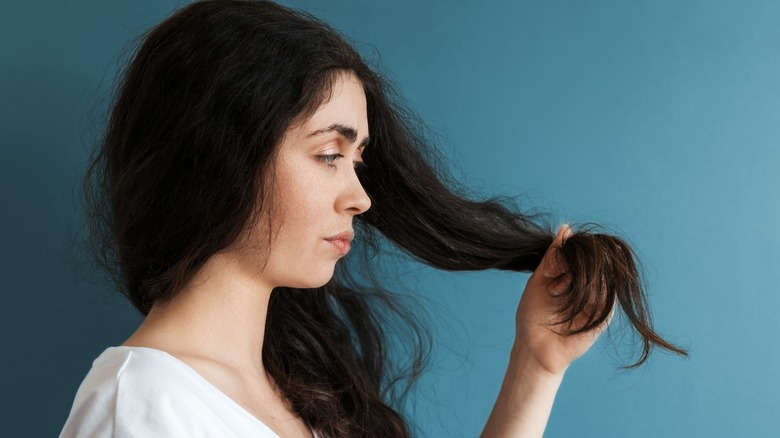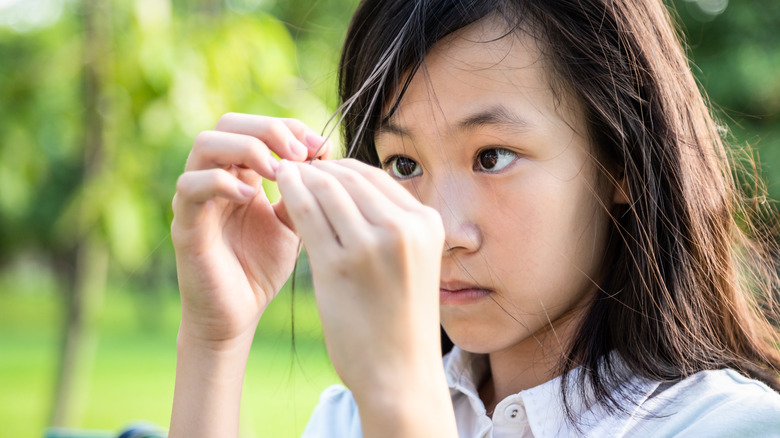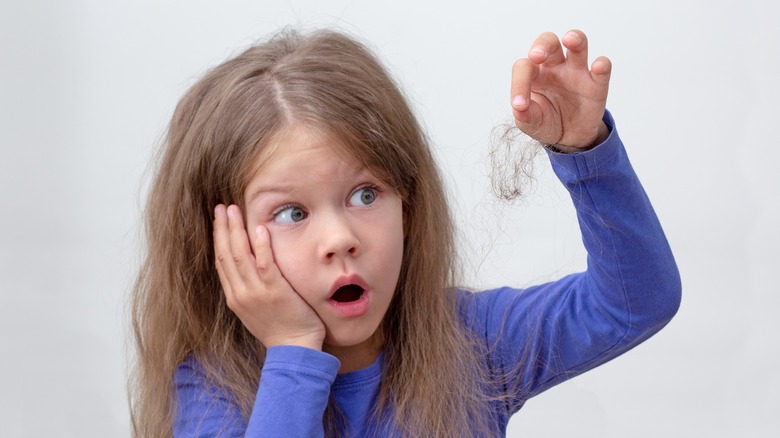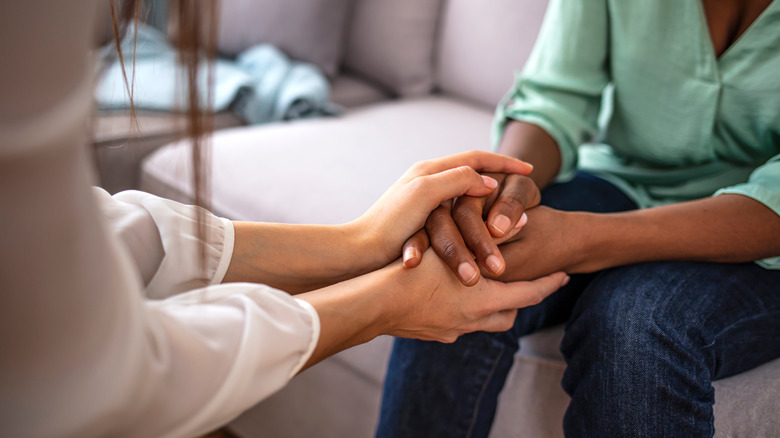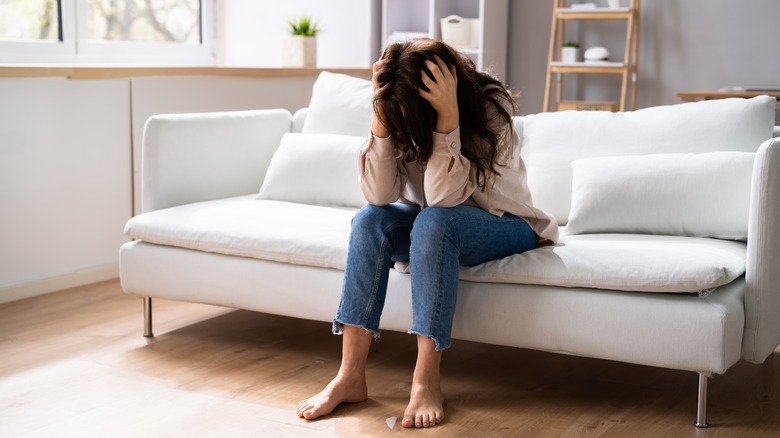Everything You Need To Know About Trichotillomania
Trichotillomania is characterized by an irresistible urge to pull hair from the scalp, eyelashes, and eyebrows (via WebMD). According to the American Psychological Association, about five to 10 million people in the United States have the condition. That's about 3.5% of the total population. If you've been diagnosed with trichotillomania, you might also be aware that hair pulling causes damage to the hair follicles. In addition to damaging hair follicles, a 2011 study published in the International Journal of Trichology warns hair pulling can also cause broken hair shafts in the skin.
Due to the negative perceptions associated with the condition, people with trichotillomania sometimes feel too ashamed to talk about it, which prevents assess to the right treatment (via Anxiety and Depression Association of America). A huge part of this shamefulness comes from a lack of awareness of the condition. Although 3% of Americans have experienced trichotillomania, not many people understand it. Being aware of the causes and symptoms of trichotillomania is the first step to reducing the triggers that cause the disorder. This guide offers everything you need to know about trichotillomania.
Causes and risk factors of trichotillomania
Health experts have yet to determine the exact cause of hair pulling (per Healthline). However, some assume it's a way of dealing with stress. For many people, hair pulling is a satisfying activity that provides relief with repeated actions. With each pull, you might feel some level of comfort.
Although pulling your hair sounds like nothing serious, it's addictive, according to the National Health Service (NHS). A 2022 study published in the journal StatPearls describes trichotillomania as an obsessive-compulsive disorder that's linked to anxiety, which stems from chemical imbalances in the motor area of the brain. Any damage to the motor complex affects how we behave, according to another 2008 study published in the journal Nature Reviews Neurosciences. Therefore, people with trichotillomania may not have full control over what they do.
Some people are more likely to develop this condition than others. The American Journal of Psychiatry says people with trichotillomania are more likely to be female or those with first-degree relatives with nail-biting habits. What's more, the disorder usually manifests around puberty, per this 2018 study published in the journal Psychiatry Research.
Symptoms of trichotillomania
The effects of trichotillomania might depend on age. While some children outgrow trichotillomania early, adults and teenagers with the condition may have more serious problems, according to the Cleveland Clinic. It can damage their skin tissues, affect their mental health, and trigger trichophagia, a condition caused by ingesting hair after pulling it out.
Trichotillomania symptoms are also mostly seen on the vertex scalp, according to a 2013 study published in the Journal of Clinical and Aesthetic Dermatology. The appearance of clinical lesions on the scalp, face, and body can all be symptoms linked to the condition. A slowly progressive non-scarring alopecia can also form as trichotillomania develops into a critical condition.
Also, people with trichotillomania tend to pick the skin, bite their nails, chew their lips, and even pull hairs from pets or dolls, per Mayo Clinic. In more serious cases, some people pull their hair intentionally, eventually developing rituals to determine which hairs to pull to get the ultimate comfort. Others pull their hair when bored or watching TV without realizing it. Despite the urge, some people can limit these actions to only pulling their hair in private.
Trichotillomania might also interfere with different aspects of life, from work to personal relationships. This is because people battling the condition have no control over their habits and feel the urge to repeat a behavior, even though it adversely affects them (via the National Institute of Mental Health).
When to see a doctor
One of the main characteristics of trichotillomania is the increasing sense of tension before pulling out your hair. It gets to a time when you might try to resist it, but you can't. That's how most addiction works. The addiction Help Guide explains that addictions maintain a strong and long-term influence on the brain. This influence manifests in an unexplained craving over the object of addiction, loss of control over the activity, and continuous involvement in the activity, regardless of its consequences.
Given this, the best time to see a doctor is when you start feeling ashamed or embarrassed about the hair-pulling compulsiveness (via Mayo Clinic). This is because trichotillomania is a mental health disorder and not just a bad habit, which can be managed easily. Without proper treatment, it's not likely to get better. By seeking help early, you can reduce the stress burden of trichotillomania.
Treatment options for trichotillomania
As of yet, trichotillomania has no cure, per Healthline. However, various options exist to treat the underlying emotions that trigger the condition. This includes reducing stress and seeking therapy. Habit reversal training, for example, helps people with trichotillomania gain more self-awareness (via Mayo Clinic). They'll be able to recognize the situations and triggers that cause hair-pulling and find other substitutes.
A 2013 study published in the journal Expert Review of Neurotherapeutics also recommends habit reversal training, praising it as the most empirically supported trichotillomania treatment available. It involves awareness training, which heightens patients' awareness of their triggers, and stimulus control, which involves methods to reduce the likelihood of continuing the habit. Another 2011 study published in the same journal explains that in addition to hypnosis, and medications, treatment options for trichotillomania in adolescents and children include supportive counseling by experts or support groups. In fact, therapies that modulate neurotransmitter systems, other than serotonin, may help reduce the urge to pull hairs in trichotillomania patients. However, the study maintains that scientific literature backing most of these approaches is still scanty.
Regarding medications, the Anxiety & Depression Association of America believes that people with trichotillomania can find some relief in serotonin reuptakes, such as clomipramine, fluoxetine, sertraline, paroxetine, lithium, valproate, and other tricyclic antidepressants. Keep in mind, it may take more than six weeks to see significant improvements. In cases where the drugs don't work as expected, it's best to consult with your doctor.
How trichotillomania relates to obsessive complusive disorder
Although trichotillomania is a mental health disorder, people commonly confuse it with an obsessive-compulsive disorder (OCD). According to OCD UK, the current Diagnostic and Statistical Manual of Mental Disorders (DSM) lists trichotillomania under the "Obsessive-Compulsive Disorder and Related Disorders" category. Regardless of their similarities, trichotillomania differs from OCD in striking ways. For instance, OCD is often driven by a person's fear of bad things happening, per Mayo Clinic. Unwanted intrusive thoughts drive these fears, and the person carries out compulsions to seemingly prevent those bad things from happening. In contrast, trichotillomania is driven by a body-focused repetitive behavior to reduce tension or stress rather than an initiation influenced by unwanted intrusive thoughts (via OCD UK).
To differentiate the two, Cleveland Clinic states that OCD involves obsessions and doesn't involve positive feelings after carrying out a compulsion. Trichotillomania, on the other hand, doesn't involve obsessions and often comes with significant relief or positive emotions after victims carry out the act.

